Human-chicken Hybrids
Page 2: Descriptions of three living specimens
EUGENE M. MCCARTHY, PHD GENETICS, ΦΒΚ
|
No monster more baneful than these, no fiercer plague or wrath of the gods ever rose from the Stygian waves. Maiden faces have these birds, foulest filth they drop, clawed hands are theirs, and faces ever gaunt with hunger.
—From Virgil’s account of the harpies, The Aeneid
|
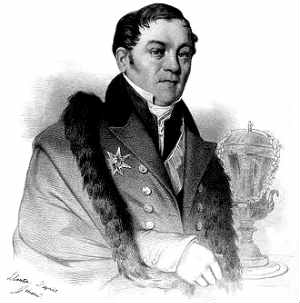 Fischer von Waldheim
Fischer von Waldheim(1771-1853)
This page quotes three separate reports about living creatures that may have been human-chicken hybrids. Two of them are from scholarly sources. The first of these reports gives a description of a hen with a human face. A translation of the original Russian report, it appeared in the October 1816 issue of the scholarly journal Annals of Philosophy (vol. 8, no. iv, pp. 241-247). The author of the article was Johann Gotthelf Fischer von Waldheim, the well-known German-born Russian naturalist.
Fischer von Waldheim was born Johann Gotthelf Fischer in Waldheim, Saxony. He studied at Leipzig, where he received a degree in medicine in 1799. He then traveled to Paris with his friend Alexander von Humboldt, where he studied under Georges Cuvier. In 1804 he became Demidov Professor of Natural History at Moscow University, as well as the director of Moscow’s Natural History Museum. In the following year he founded the Moscow Society of Naturalists, one of the city’s oldest learned societies, of which he served as president. Due to his scholarly achievements, the Russian government granted him nobility, as well as the “von Waldheim” ending to his name. However, his paper transcribed below was published prior to his elevation to the nobility so his name is given simply as “Professor Fischer.”
During the course of his work as director of the museum, he received specimens from all parts of Russia. One year, he was sent a very exceptional living specimen, a chicken with a human face, which he formally described. A transcript of his description, in English translation, appears below, together with illustrations of the animal that accompanied the article. The illustrations were prepared by one of the university’s artists, a Mr. Valesicon. They show three views of the face of the creature (which didn’t differ from ordinary chickens with respect to other portions of its body). A footnote on the first page of this article states it was “Translated almost verbatim from the Russ[ian] with some additions from the German edition by Dr. Lyall, Physician to Count Orlof at Moscow.”
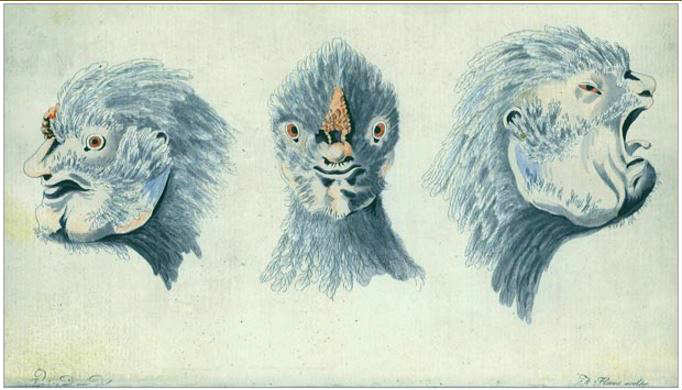 Fischer’s human-chicken hybrid. The original figure legends, from the English translation (Fischer 1816, p. 247), read: “Fig. 1 is a true profile of the hen’s face, like to that of an old woman. Fig. 2 is a front view of the head. Fig. 3 is a profile view of the head, with the mouth open to show the tongue.” The figure itself is taken, however, from the frontispiece of Fischer’s original Russian publication (Фишер фон Вальдгейм, Г.И. 1815. Описание курицы, имеющей в профиле фигуру человека. Москва, в Университетской типографии.).
Fischer’s human-chicken hybrid. The original figure legends, from the English translation (Fischer 1816, p. 247), read: “Fig. 1 is a true profile of the hen’s face, like to that of an old woman. Fig. 2 is a front view of the head. Fig. 3 is a profile view of the head, with the mouth open to show the tongue.” The figure itself is taken, however, from the frontispiece of Fischer’s original Russian publication (Фишер фон Вальдгейм, Г.И. 1815. Описание курицы, имеющей в профиле фигуру человека. Москва, в Университетской типографии.).
Description of a Hen having the Profile of the Human Face, with some Observations. By Professor Fischer
Never has a hen attracted so much attention; never has any animal, even the most rare, so greatly excited the curiosity of the public, as the hen with the human profile, which was found in the Belyovsky district of the province of Tula, and sent to the Imperial University of Moscow, by his Excellency the Civil Governor, Mr. Bogdanoff.
I had no sooner received this hen with the human profile than the curious presented themselves to see it; and the number of visitors increased so greatly, from day to day, from hour to hour, that frequently my chamber could not contain them; so that I was obliged to fix certain days for exposing this animal to public view.
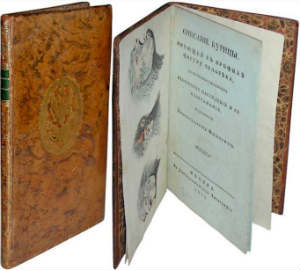 Russian original of Fischer von Waldheim’s report (offered here in English translation).
Russian original of Fischer von Waldheim’s report (offered here in English translation).
For the satisfaction of such individuals as have not had an opportunity of seeing this animal, I here present them with a faithful sketch accompanied with some observations.
The hen is of the middle size, i.e., eight inches high, and fourteen long; her feathers are of a pearlish grey colour, and brown in some places, particularly at the points. The form of her body as well as her manner of living is the same as that of other hens; but her head presents an extraordinary phenomenon; for, at the place where the beak ought to be, she exhibits a human profile, resembling that of an old woman. The beak is entirely wanting; and the jaw-bones, or jaws, are shortened in such a manner that they terminate where, in other hens, the nostrils are found. They are covered with flesh, and resemble lips. The comb, in a front view, in this hen, forms a kind of nose; which appears the more astonishing, as the nostrils are found between the termination of the nose and the jaw; but we are most liable to be deceived, when we see, as sometimes happens, some drops of liquid in them, or when the dust is accumulated there. To the inferior jaw is attached a fleshy excrescence, not to be found in other hens, and which forms a kind of chin. This chin is bare, or naked, with the exception of some hairs of beard, and is prolonged with naked skin, even to the ears, as in other hens. The eyes are round and black, and surrounded with an iris of a cinnabar-red colour. The parts of the head under the eyes are of a flesh colour, mixed with blue, and almost naked, or covered, like the chin, with a kind of stiff hairs, which form towards the ears, a sort of whiskers, and conceal the aperture of the ear. (See Plate LVI. Fig. 1.) These peculiarities of the head, united, present a great resemblance between the profile of this hen and that of an old woman, particularly if one does not attend to the tuft of feathers on the head of this animal; and the longer and more attentively we look at this profile, especially when the hen feeds, the more striking does the resemblance become. In consequence of this conformation, the animal cannot take the kind of food which suits it. As the beak is wanting, and has for substitute a kind of mouth, it is very difficult for her to eat, and still more so to collect grains. The too great advancement of the nostrils prevents her altogether from drinking; it is, therefore, necessary to feed her with bread soaked in water, or in milk. She prefers eating white bread with cream; and when hemp-seeds are presented to her in the hand, she appears to swallow them with great avidity; yet she likes, as well as all other hens, hashed meat, corn, &c. I have heard that she has also been seen to eat cheese with much eagerness. She is very tame, as is the case with all birds which have the beak maimed, whether done by the hand of man, or by chance. She prefers eating from the hand, as the soft parts about the mouth (the comb and under the chin), are soon injured when she is obliged to peck her nourishment on hard bodies.
Since I have had her in my chamber, and nourished her from my hand, she knows me very well, and approaches the place where I sit, whether while dining or drinking tea, and calls for something to eat by a particular cry. Her voice, although feeble, resembles that of other hens; and often, when alone, she cackles like a hen about to lay. Notwithstanding the loss of the beak, after having eaten, she makes the ordinary motions of the head, to wipe and clean the two sides of the jaw upon hard bodies, as on the table or the ground. This hen appears better pleased to be in human society than among other fowls. When another hen is carried into the chamber, and placed near her, she begins to be angry, lets her wings fall, swells and raises herself, and makes a noise like that of a cock which is preparing for combat. In the kitchen she is at continual warfare with the other hens, which she chases; but she herself takes to flight as soon as she perceives the cock. The cock appears now, however, to inspire more confidence; and we have the best founded hope that a favorable connexion will take place between them. In the open air she appears to be timid; and she conceals herself among the grass on the approach of crows or birds of prey, or on the least noise. If she happens to be at the chamber window, and to observe crows passing, she sinks at every one of their movements, and gapes with fear. This hen was changing her feathers when I received her (four months ago), and the change is not yet finished, which proves that it is more slowly effected than in other hens, because her nourishment being insufficient renders her unhealthy, yet the feathers become more thick and lucid, and the plume on the head and neck is become much more bushy. The feet are strong, and the scales which cover them are almost the same as those of a hen of two years of age. She is without the spurs; and I am unable to determine whether she was hatched without them, or has lost them in battle, or by cold. On the right foot one nail is deficient, and on the left two.
This is a true description of the hen and of the facts which I have observed.
The substance of Fischer’s report was later confirmed in a paper by his friend and colleague Heinrich von Martius (1781-1831),§ a German physician who worked for some years as a conservator at the Natural History Museum in Moscow. Thirteen years after his return to Germany, von Martius (1829) wrote up an account of his own eyewitness experiences with von Fischer’s “chicken” that agreed in all its particulars with the account given by Fischer. Von Martius (pp. 315-316) even went so far as to consider the taboo and speculated that this creature had a sexual origin:
In an addendum to his article (see p. 245), Fischer mentions that “Ten years ago there was exhibited publicly in Poland a hen which resembled ours.” This, no doubt, refers to the creature described in the following article (quoted in translation), which appeared on p. 44 of the February 6, 1804, issue of the German newspaper Prager Patriotische Zeitschrift, a newspaper published in Prague (source):
A chicken with a human face
A Jew in Poznań in South Prussia exhibited a chicken with a human face. It hatched from an egg that had been laid on a estate at Września in the Province of Poznań.
The Jew received it in payment for tailoring work from a farmer who assured him the same hen had hatched a similar chicken that had died soon thereafter. The surviving chicken, which the Jew had on display, seemed quite healthy, was full grown and over a year old.
Its body was covered with colored feathers, and up to the part of the neck where the head began, it differed not in the least from other chickens. The head was no larger than in other chickens, but it was featherless and covered with skin of a somewhat blueish color. The eyes were shaped exactly as in a human, and above them two arches of very fine hair formed well-defined eyebrows. The upper part of the beak was so blunt that it had the appearance of a well-formed nose, but it differed from an ordinary nose in that it was coated with horn [that is, with the same thin keratinized layer of epidermis that covers bills in ordinary birds].
Beneath the nose was a regular human mouth, with two lips and two tight rows of white teeth, perfecting the resemblance. The tongue was rounded and shaped like a human tongue. The whole face, in fact, so perfectly resembled a human face, to the last detail, that one cannot imagine how the resemblance might have been improved. These facts are attested by Herr Schwarz in Poland. [Translated by E. M. McCarthy. Original German English version]
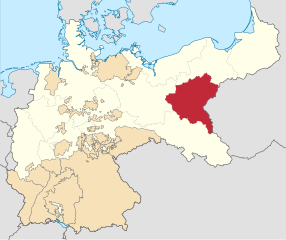 Province of Poznań (red) within Prussia (white) and the German Empire (white, beige and red). Image: Wikipedia.
Province of Poznań (red) within Prussia (white) and the German Empire (white, beige and red). Image: Wikipedia.
The city of Poznań lies today in west-central Poland. After the Second Partition of Poland in 1793 Poznań was administered by the Kingdom of Prussia and was the capital of the Province of Poznań. The Polish city of Września, too, was annexed by Prussia in 1793.
Johann Ludwig Georg Schwarz (1759-1830) was a senior Prussian government official (“Regierungsrat”) stationed for a time in Poznań (more about Schwarz). Schwarz was the husband of the German author Sophie Schwarz (1754-1789). His original report about this hybrid appeared in the newspaper Brennus: Eine Zeitschrift für das nördliche Deutschland in 1802 (vol. 1, issue 3).
The report’s mention of another such creature being produced by the same chicken suggests that hybrids of this type may not be that rare, and that they may instead be underreported. After all, how rare could they be if the same hen managed to produce two?
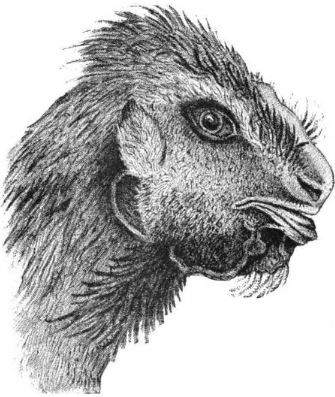 Illustration in the Feb. 9, 1878 issue of Scientific American.
Illustration in the Feb. 9, 1878 issue of Scientific American.
New York, 1878. Another report describes a specimen, pictured at right, as having a face like a monkey. However, it looks enough like the specimens in the other two cases quoted above that it seems appropriate to include it here. Either type of hybrid, whether a cross between a monkey and a chicken, or a human and chicken, would be equally remarkable, given that both would represent interclass crosses. The author of the article, John Michels, was the founder of the journal Science, together with Thomas Edison. This report appeared in the Scientific American (Feb. 9, 1878, p. 89):
A FOWL MONSTROSITY
BY JOHN MICHELSThe illustration will convey an excellent conception of the peculiarities of the fowl in question, which is said to have a monkey's face. It will be noticed that the ordinary beak of a bird is absent, and that the nose and lips of an animal are fully developed.
The nose appears to be formed by an extension of the comb, which at the point of junction suddenly changes from a bright red to a pale fleshlike color; the lips, which are large and protruding, having the same hue.
Both lips and nose are formed of a moderately hard cartilaginous substance,‡ having a smooth surface, the nostrils being very similar to those observed in many species of monkeys.
The tongue is also modified in form, rounded at the point and having unusual power of lateral motion.
With the exceptions I have named, or shown in the illustration, the general appearance of the specimen is normal, and indicative of its being of the Cochin China breed.
Interestingly, specimens similar to those described on this page have been informally reported in American newspapers.
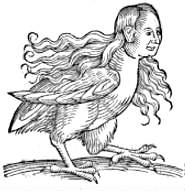
Also fascinating is a related case, which appears at the bottom of another page on this website as a screenshot of a news story. It describes what may have been an extremely bizarre human-cat-chicken three-way hybrid, a veritable sphinx in modern times. Learn more >>
By the same author: Handbook of Avian Hybrids of the World, Oxford University Press (2006).
|
It is stated in the annals that, during the consulship of M. Lepidus and Q. Catulus, on the farm of a certain Galerius living near Rimini, a chicken spoke with a human voice, a thing I have not heard of elsewhere.
—Pliny the Elder
The Natural History, Book X, xxv† |
|
† Original Latin of translated passage: invenitur in annalibus in agro Ariminensi M. Lepido Q. Catulo cos. in villa Galerii locutum gallinaceum, semel, quod equidem sciam. |
Most shared on Macroevolution.net:
Human Origins: Are we hybrids?
On the Origins of New Forms of Life
Mammalian Hybrids
Cat-rabbit Hybrids: Fact or fiction?
Famous Biologists
Dog-cow Hybrids
Georges Cuvier: A Biography
Prothero: A Rebuttal
Branches of Biology
Dog-fox Hybrids
 Dog-chicken hybrids >>
Dog-chicken hybrids >>